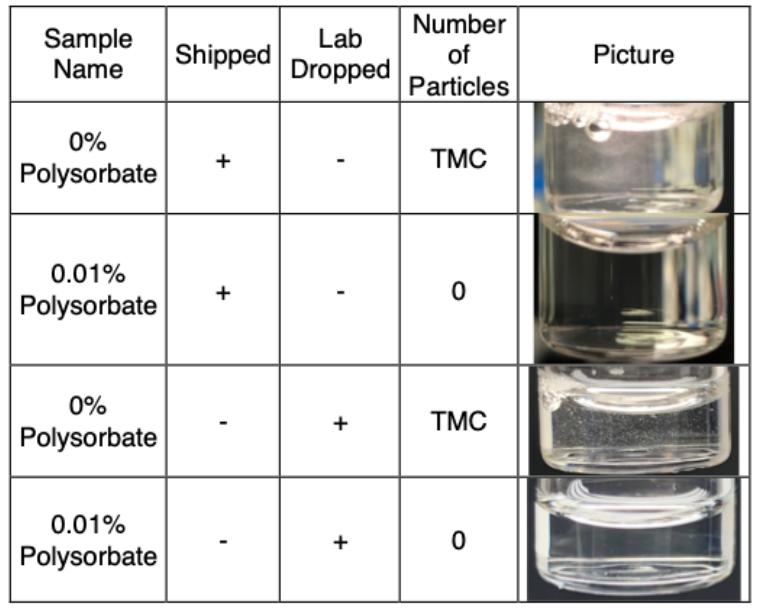Creative Proteomics places at the disposal of its clients an innovative and reliable visible particle analysis services. Through harnessing state-of-the-art technologies and sophisticated methodologies, this service scrutinizes, quantifies, and analyzes visible particulates across a broad spectrum of specimens. This critical service assists clients in enhancing their product's quality and safety measures and also deepens their comprehension of their research materials, in line with the stipulations of the ICH Q6B guidelines.
Introduction to Visible Particles
Visible particles represent the tiniest units of matter observable to the naked eye. In the realm of physics, these particulates serve as intrinsic elements of the natural world, paralleling atoms or molecules in their fundamental nature. From solid entities like dust or pollen to liquid ones such as droplets of water or fog, a spectrum of visible particles exist, each interacting and behaving differently.
 Fig 1. Visible particles in shipped and lab dropped vials. (Siska, C., et al. 2019)
Fig 1. Visible particles in shipped and lab dropped vials. (Siska, C., et al. 2019)
These particles can either exist naturally or can be brought into existence through anthropogenic activities. Dust particulates, for instance, are an intrinsic component of air ambience, but human endeavours like construction or agriculture can exacerbate their quantity. Similarly, while water droplets naturally constitute part of atmospheric composition, their prominence can be amplified through human activities like irrigation and steam-based industrialization.
Visible particles hold a pivotal role across a multitude of scientific disciplines. For environmental scientists and climatologists, particle study provides imperative insights into air quality and consequences on climate change. In the medical realm, ascertaining the behaviour of microscopic entities such as viruses or bacteria is pivotal for pharmacological advancements including drug treatment and vaccines.
Analysis of Visible Particles

An investigation of visible particles might include the following considerations:
Classification and quantity: A crucial element of visible particle analysis involves identifying and quantifying them, enabling the comprehension of their makeup and relative proportions.

Dimensions and form: Another essential aspect of the analysis necessitates the measurement of each particle's size and shape. This procedure could potentially employ image analysis or specialized measuring tools to decipher the physical attributes and size distribution of these particles.

Coloration and surface shininess: Color and gloss examination significantly contributes to particle analysis. This could demand an evaluation of each particle's color and gloss, facilitating comprehension of their optical properties and appearance traits.

Particle origin and composition: The determination of the source and composition of visible particles is another key element of the analysis. This can potentially involve the examination of the particles' chemical makeup, providing insights into the elemental or compound substances they contain.
How to Detect Visible Particles?
The quantification and characterization of particulate matter, inclusive of dust, pollen, and other micro-particles, can be accomplished through an array of methodologies and apparatus. These include:
- Optical Microscopy: The rudimentary technique where particulates are examined directly via microscopy.
- Laser Light Scattering: In this method, a laser beam traverses a sample laden with particles. The light, upon encountering these particles, disperses, creating a scattered light pattern that serves to appraise both the particulates' dimensions and abundance.
- Infrared Sensors: Employed to determine the concentration of particulates, these sensors calculate the quantity of infrared light either absorbed or scattered by the particles.
- Digital Imaging: A digital representation of the sample is captured and then subjected to software algorithms in order to analyze the numeration and sizing of visible particulates.
When dealing with particulates of a minute scale that may eschew the human eye, more sophisticated techniques like Scanning Electron Microscopy (SEM) or Transmission Electron Microscopy (TEM) may be employed. Favoring electrons over light for sample analysis, these techniques quantify and characterize particulates based on the atomic interactions within the samples.
Our Advantages

Our Commitment and Future Goals
As a preeminent authority in the field of proteomics and biomarker discovery, Creative Proteomics is pleased to furnish a supreme service in visible particles analysis. Utilizing cutting-edge techniques and advanced instruments, our seasoned team of researchers meticulously dissect and characterize visible particles found in a wide range of samples. Our expert analysis elucidates key aspects such as composition, size distribution, morphology, and potential origins. For inquiries or further discussion, we warmly invite you to get in touch with us.
Reference
- Siska, C., et al. Shocking Data On Parcel Shipments of Protein Solutions. Journal of Pharmaceutical Sciences. 2019.
Related Sections
Services
Applications
For research use only, not intended for any clinical use.


 Fig 1. Visible particles in shipped and lab dropped vials. (Siska, C., et al. 2019)
Fig 1. Visible particles in shipped and lab dropped vials. (Siska, C., et al. 2019)




